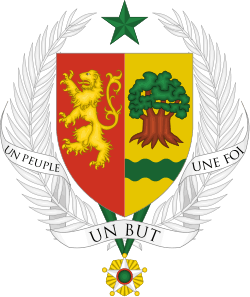Armed Forces of Senegal
The Armed Forces of Senegal (French: Forces armées du Sénégal) consists of about 17,000 personnel in the army, air force, navy, and gendarmerie. The Senegal military force receives most of its training, equipment, and support from France and the United States. Germany also provides support but on a smaller scale.
| Senegalese Armed Forces | |
|---|---|
| Forces armées du Sénégal | |
| Founded | 1962 |
| Service branches | Army Navy Air Force National Gendarmerie |
| Leadership | |
| President | Macky Sall |
| Minister of Defence | Sidiki Kaba |
| Chief of General Staff | General of Air Corps Birame Diop |
| Manpower | |
| Available for military service | 1,158,893 (2000 est.), age 15–49 (2,218,920 (2000 est.)) |
| Fit for military service | 109,381 (2000 est.), age 15–49 (2,218,920 (2000 est.)) |
| Reaching military age annually | (2,218,920 (2000 est.)) |
| Active personnel | 17,000 |
| Expenditures | |
| Budget | ~ $350 million (FY2018) |
| Percent of GDP | ~1.5% (FY2018 est.) |
| Industry | |
| Foreign suppliers | |
| Related articles | |
| History | Mauritania–Senegal Border War Casamance conflict Gulf War Guinea-Bissau Civil War Insurgency in the Maghreb 2008 invasion of Anjouan Saudi Arabian-led intervention in Yemen Invasion of the Gambia |
| Ranks | Rank insignia |
Military noninterference in political affairs has contributed to Senegal's stability since independence. Senegal has participated in many international and regional peacekeeping missions. Most recently, in 2000, Senegal sent a battalion to the Democratic Republic of Congo to participate in MONUC, the United Nations peacekeeping mission.
Senegal also agreed to deploy a United States-trained battalion to Sierra Leone to participate in UNAMSIL, another UN peacekeeping mission. The training operation was designated Operation Focus Relief and involved U.S. Army Special Forces from 3rd Special Forces Group training a number of West African battalions, including Nigerian ones.
As one of the largest troop contributors in Africa (per capita) to African Union missions, United Nations missions, and other regional security organizations, the Senegalese military has proven itself to be one of the most effective and reliable militaries on the African continent. This is remarkable given that Senegal is poorer than the average Sub-Saharan African country. Most importantly, the army of Senegal is multi-ethnic, not coup-proofed, and has never attempted a coup d'état, which is a rarity in Africa. Harmonious Senegalese civil-military relations since Independence have permitted the creation of an effective 'military enclave' that is a capable institution that is not a threat to the political leadership in Dakar.[1]
Lists of Chiefs of Defense Staff Senegal
- General AMADOU FALL (1960) Chief of Staff of the Senegalese Armed Forces
- Colonel Soumaré (- 19 August 1960) Chief of Staff of the Federation of Mali
- Colonel Idrissa Fall (August 20, 1960 - 1962)
- Major General Jean Alfred Diallo (from 17/12/1962 to 30/06/1972)
- General Idrissa Fall (from 01/07/1972 to 30/06/1984)
- General Joseph Louis Tavarez de Souza (from 01/07/1984 to 31/05/1988)
- General of Air Corps Mamadou Mansour Seck (from 31/05/1988 to 30/06/1993)
- General Mouhamadou Lamine Keita (from 30/06/1993 to 30/06/1996)
- General of the army Lamine Cissé (from 01/07/1996 to 31/12/1997)
- Major General Mamadou Seck (from 01/01/1998 to 30/04/2000)
- Lieutenant General Babacar Gaye (from 01/05/2000 to 12/08/2003)
- Lieutenant General Papa Khalilou Fall (from 12/08/2003 to 31/05/2006)
- Lieutenant General Abdoulaye Fall (01/06 / 2006-30 / 10/2012)
- General Mamadou Sow (30/10 / 2012-31 / 12/2016)
- Major General Cheikh Gueye (01/01/2017-31/12/2019)
- General of Air Corps Birame Diop (01/01/20-
Summary of past military actions
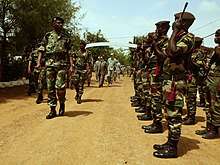
- In October 1980 and August 1981, the Senegalese military was invited into the Gambia by President Dawda Kairaba Jawara to put down a coup attempt.[2]
- In August 1989, Senegalese-Gambian military cooperation ceased with the dissolution of the Senegambian Confederation.
- In 1990, 500 Senegalese troops were deployed to Saudi Arabia to take part in the Gulf War. 92 of them were killed after the end of the conflict in a plane crash on 21 March 1991.
- In 1992 1,500 men were sent to the ECOMOG peacekeeping group in Liberia.
- In 1994, a battalion-sized force was sent to Rwanda to participate in the UN peacekeeping mission there.
- Senegal intervened in the Guinea-Bissau civil war in 1998 at the request of former President Vieira.[3]
- A Senegalese contingent deployed on a peacekeeping mission to the Central African Republic in 1997.
- In 2017, Senegal deployed troops into the Gambia to support newly elected President Adama Barrow, an action legally justified by UN resolution 2337.
The Army (Armée de Terre) is the leading force within the Senegalese armed forces and provides the chief of staff and the Inspecteur général des forces armées.
Army

Since independence the army has gone through a large number of reorganisations. The army's heritage includes the Tirailleurs sénégalais. In 1978, Senegal dispatched a battalion to the Inter-African Force in Zaire, in the aftermath of the Shaba II fighting. The Senegalese contingent was under the command of Colonel Osmane Ndoye.[4] The Senegalese force comprised a parachute battalion from Thiaroye.
The Army currently consists of two divisions, the Operations Division and the Logistic Division. The IISS estimated in 2012 that the Army had a strength of 11,900 soldiers, three armoured battalions the 22nd, 24th, and 25th (at Bignona) and the 26th Bataillon de reconnaissance et d'Appui at Kolda; there are six infantry battalions numbered 1st to 6th.[5] 3rd Battalion may have been at Kaolack with 4th at Tambacounda at one point.[6]
Also reported is the 12th Battalion of the 2nd Military Zone at Saint Louis (Dakhar Bango),[7] along with the Prytanée militaire de Saint-Louis, a military secondary school.
Although the Senegalese Air Force is geared towards supporting it, the army may have previously maintained its own very small aviation branch, called the "Aviation Légère de l'Armée de Terre" (like the French army's equivalent), which may have counted up to five light helicopters and two SA330 Puma transport helicopters. The IISS Military Balance 2012 does not list any helicopters in army service.
National Gendarmerie
The Gendarmerie is a military force which provides policing and security. It includes a Territorial Gendarmerie with general policing duties, and a Mobile Gendarmerie for special tasks and serious public disorder.
The Senegalese gendarmerie evolved out of a French colonial Spahi detachment sent to Senegal in 1845. This detachment (which became today's Red Guard of Senegal) was the cadre around which the "Colonial Gendarmerie" was formed. On independence this became the National Gendarmerie.
The commander is General Abdoulaye Fall (a different person from the current Armed Forces Chief of Staff of the same name), whose rank is Divisional General, and whose full job title is "High Commander of the Gendarmerie and Director of Military Justice".
Navy
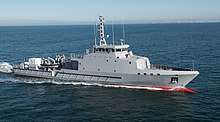
%2C_left%2C_patrols_along_side_the_Senegalese_Navy_vessel%2C_Poponquine%2C_during_joint_operations_as_part_of_the_Africa_Partnership_Station.jpg)
The navy (marine), also known as the Armée de mer, is of small size and is commanded by a ship-of-the-line captain. It is responsible for securing Senegal's 286-nautical-mile (530 km; 329 mi) Atlantic coastline which is strategically located on the extreme west of the African continent. The coastline is divided in two by The Gambia. The navy was created in 1975.[8] The Navy operates two bases, one at Dakar and the other at Elinkine. The navy also patrols the 12 nautical miles (22 km; 14 mi) territorial waters as well as a declared 200-nautical-mile (370 km; 230 mi) exclusive economic zone.[9][10]
The Navy is divided into three branches known as "groupings":[11]
- The Operational Naval Grouping (Groupement Naval Opérationnel), which is divided into three flotillas and one group:
- The High Seas Patrol Boats (Patrouilleurs de Haute Mer),
- The Coastal Surveillance Vessels (Bâtiments de Surveillance Côtière),
- The Fast Coastal Boats (Vedettes Côtières Rapides) and
- The Transport Group (groupe de transport).
- The Naval Support Grouping (Groupement de Soutien de la Marine) responsible for ports, repairs, training, and logistics.
- The Fluvial-Maritime Surveillance Grouping.
Air Force

The air force (Armée de l'Air) is orientated towards providing support for ground forces and resembles an army aviation corps. It has no air-to-air combat aircraft, but possesses Mil Mi-24 gunship helicopters, transport helicopters and aeroplanes, and reconnaissance helicopters and aeroplanes. This small force is commanded by a colonel.
Military zones
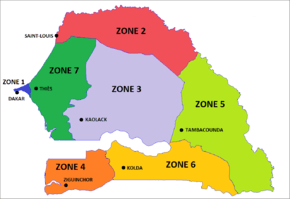
At the present time, there are seven military zones:[12]
- Zone n°1 - Dakar
- Zone n°2 - Saint-Louis
- Zone n°3 - Kaolack
- Zone n°4 - Ziguinchor
- Zone n°5 - Tambacounda
- Zone n°6 - Kolda
- Zone n°7 - Thiès
Each zone comprises a garrison office which caters to military issues and a social service office. The IISS Military Balance listed four zones in 2007.
Equipment
Armored cars
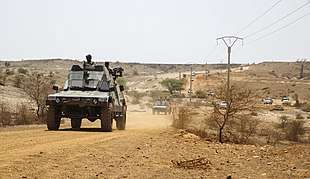
- 30 Panhard AML- 60mm 4x4
- 74 Panhard AML- 90mm 4x4
- 13 WMA301/PTL02 105 mm tank hunter
- 50 RAM MK3
- 10 M8 Greyhound 37mm 6x6
- 4 M20 Greyhound 6x6
Armoured personnel carriers
- 8 Casspir 4x4
- 24 Panhard M3 4x4
- 12 M3 Half-track
- 6 Dozor-B
- 39 PUMA M26-15
Other 'soft-skin' military vehicles not listed by the IISS:
Artillery
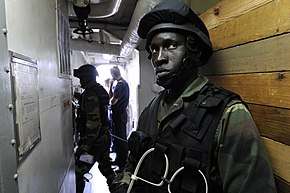
- 6 M-50 155mm Howitzer
- 8 TRF1 155mm Howitzer[13]
- 6 M-101 105mm Howitzer
- 6 KrAZ-6322PA Bastion-01 122mm multiple rocket launcher
Mortars:
Anti-tank weapons:
Air defence weapons:
- 21 53-T-2/M-693 20mm AAGs
- 12 Bofors L-60 40mm AAGs
Source: IISS Military Balance 2012, 450.
Aircraft
Citations
- Matisek, Jahara (March 2019). "An Effective Senegalese Military Enclave: The Armée-Nation "Rolls On"". African Security. 12: 62–86. doi:10.1080/19392206.2019.1593004.
- Ndiaye, Ndèye Fatou; Sané, Chamsidine (17 January 2017). "Opérations en Gambie : Il était une fois "Fodé Kaba 1" et "Fodé Kaba 2"". seneweb.com (in French).
- "Guinea: Senegal Sends Troops To Bissau". allafrica.com. 12 June 1998.
- "Le Potential". Archived from the original on 2014-03-29. Retrieved 2014-03-29.
- IISS Military Balance 2012, 449.
- "Archived copy". Archived from the original on 2014-03-29. Retrieved 2012-06-30.CS1 maint: archived copy as title (link)
- http://www.lequotidien.sn/index.php/societe/item/11420-saint-louis-en-visite-au-12e-bataillon--macky-sall-promet-de-meilleures-conditions-de-travail%5B%5D
- Gonzalez, Flor (28 January 2020). "U.S. Africa Command continues to develop Senegal's Enlisted Development Strategy". United States Africa Command. Retrieved 24 May 2020.
- Gardiner, Chumbley & Budzbon 1995, p. 330.
- Saunders 2009, p. 717.
- Bryden & N'Diaye (eds), 'Security Sector Governance in Francophone West Africa, DCAF, 2011, 207.
- État Major des Armees, Zones militaires Archived July 26, 2009, at the Wayback Machine, accessed August 2009
- http://far-maroc.forumpro.fr/t449p150-armee-senegalaise
Part of this article is derived from the equivalent article at French Wikipedia
References
- Gardiner, Robert; Chumbley, Stephen & Budzbon, Przemysław, eds. (1995). Conway's All the World's Fighting Ships 1947–1995. Annapolis, Maryland: Naval Institute Press. ISBN 1-55750-132-7.CS1 maint: ref=harv (link)
- Saunders, Stephen, ed. (2009). Jane's Fighting Ships 2009–2010 (112 ed.). Alexandria, Virginia: Jane's Information Group Inc. ISBN 0-7106-2888-9.CS1 maint: ref=harv (link)
.jpg)
